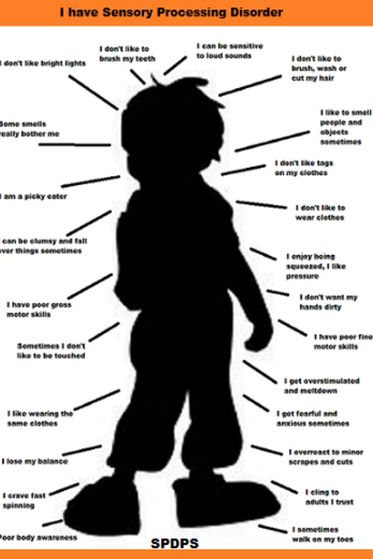According to Ausderau, et al. (2014), there are four sensory response categories, or sensory patterns. They are –
1. HYPO (under active), considered a lack of or delayed response to sensory input, or even lack of orienting to loud sounds and slow to react to pain.
2. HYPER (over active), is defined by an exaggerated or avoidant response to sensory stimuli. Such as discomfort to grooming (dressing) activities, covering ears in response to sounds.
3. SIRS (sensory interests, repetitious & seeking behavior), is characterized by fascination with or craving the sensory stimulation as with flickering lights or rubbing textures.
4. EP (enhanced perception) has emerged as the fourth pattern of sensory response possibly unique to individuals with ASD. EP is characterized by strengths in locally oriented visual and auditory perception and enhanced low-level discrimination or low threshold detection and hyper-systemizing cognitive styles.
< My Thoughts > "...four sensory response categories, or sensory patterns."
The four 'sensory response' categories/patterns, according to Ausderau, et al. (2014), are Hypo-Activity, Hyper-Activity, SIRS (Sensory Interests), EP (Enhanced Perception). My attempt here is to understand them one at a time, starting with BLOG #5H - 1. Hypo-Activity.
1. HYPO-ACTIVITY… (under active), Ausderau finds that the brain is deprived because too little stimulation gets in and the channel is not open enough. The sensory system is under-responsive. Or, the normal processing of smells, sights, sounds, touch, and movement is dulled, under-developed, or processing the stimuli incorrectly.
Always on the move… frequently twirling, spinning, running round & round. Attracted to lights. Rocks back & forth when watching TV. Likes to look at things upside down. No safety awareness. Jumps off furniture & high places; loves the trampoline. Often sudden outbursts of self abuse. Easily vomits from excessive movements. Has difficulty changing body position. Shuts out the world when engaged in body movements. Thinks in movements.
Has low muscle tone, weak grasp, drops things. Doesn’t feel hunger. Likes to lean on things & people. Bites & sucks on fingers & hands. Chews on things, grinds teeth. Hits, bumps & pushes others. Enjoys crashing into things. Intentionally falls on the floor. Engages in ritualistic body movements when frustrated or bored. Watches feet when walking & hands when doing something. Talks about non-existent experience… “I am flying…”.
Sabatos-DeVito, et al. (2016) explain that hypo-responsive behaviors are particularly associated with autism and have been reported as early as 9-12 months of age. They also point out that hypo-responsive children may be less sensitive to novelty, thus taking longer to notice and process ‘novelty’ in the environment.
< My Thoughts > “…taking longer to notice and process ‘novelty’ in the environment.”
To better understand why taking longer to notice and process ‘novelty’ in the environment can become a critical issue, here is a quote from Evans, et al. (2012) – “Children scoring high on ‘novelty’ awareness tend to be more social, can control impulses, and are better able to comply with tasks they are given.”
As you can see, the hypo-responsive child doesn’t recognize that this ‘novelty’ may be something new and fascinating in their environment. Without being able to peak the child’s interest, the parent, teacher, or clinician will have difficulty finding a teachable moment which can bring the child closer to learning. My own son becomes so fixed on what he is looking at that he refuses to disengage long enough to see a new toy or puzzle. Then when he finally responds, maybe hours later, he gives it the ole periphery look, out of the corner of his eye as he passes by. Smiles.
REFERENCES used here are:
Ausderau, K., Sideris, J., Furlong, M., et al. (2014). National Survey of Sensory Features in Children with ASD: Factor Structure of the Sensory Experience Questionnaire; Journal of Autism Developmental Disorders; V44, p915–925.
Evans, C., Nelson, L., Porter,C. (2012). Making Sense of Their World: Sensory Reactivity & Novelty Awareness as Aspects of Temperament & Correlates of Social Behaviors in Early Childhood; Journal of Infant & Child Development; V21, p503-520.
Sabatos-DeVito, et al. (2016). Eye Tracking Reveals Impaired Attentional Disengagement Associated with Sensory Response Patterns in Children with Autism; Journal of Autism Developmental Disorders; V46, p1319–1333.
==============
READ MORE... Click here =>


 RSS Feed
RSS Feed